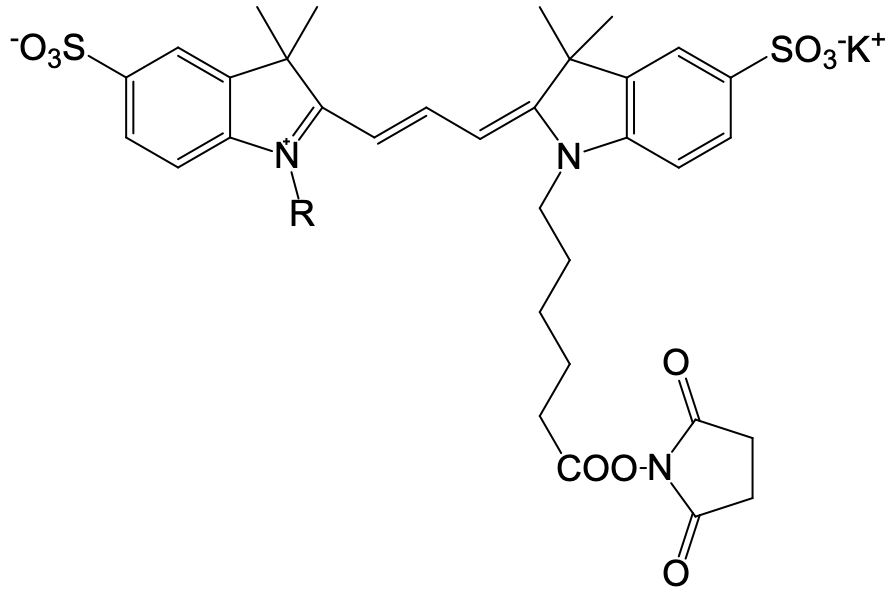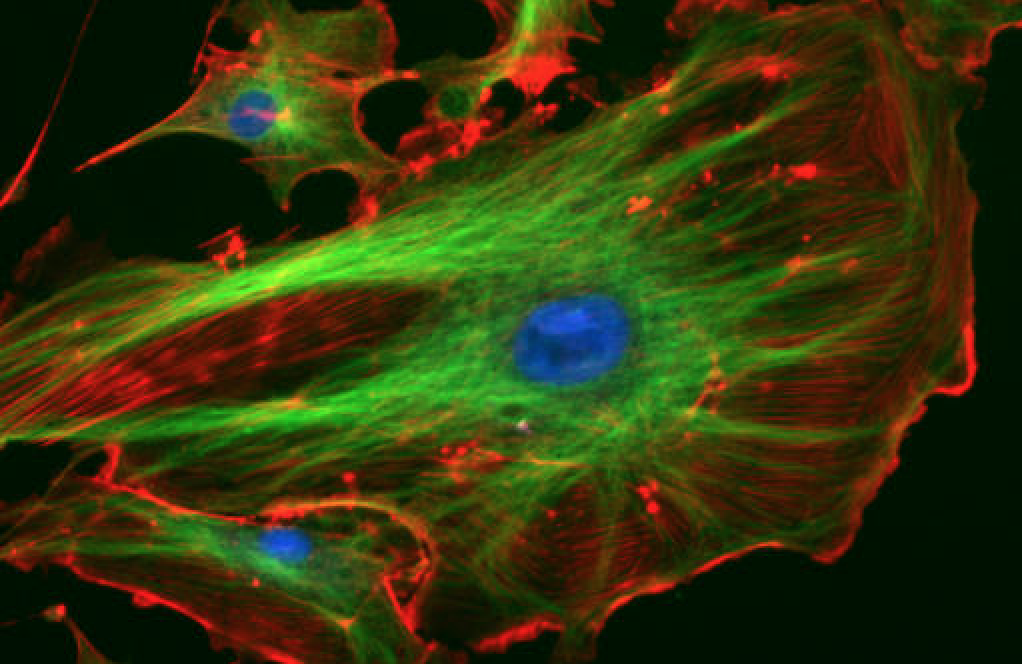Sulfo-Cy3 SE
Water soluble, amino-reactive sulfo-Cyanine3 NHS ester. Efficiently labels proteins and peptides in purely aqueous solution, without need for organic co-solvent. Ideal for proteins with low solubility, and proteins prone to denaturation.Cy3 NHS ester readily reacts with amino groups. A variety of cyanine 3 dyes has been used to label biological molecules for fluorescence imaging and other fluorescence-based biochemical analysis. They are widely used for labeling peptides, proteins and oligos etc. Cy3 dyes have enhanced fluorescence upon binding to proteins.
| Molecular weight | Excitation (nm) | Emission (nm) | Extinction coefficient (cm-1 M-1) | Quantum yield | Correction factor (280 nm) |
| 765.93 | 555 | 569 | 150000 | 0.15 | 0.073 |

Succinimidyl esters are proven to be the best reagents for amine modifications because the amide bonds that are formed are essentially identical to, and as stable as the natural peptide bonds. These reagents are generally stable and show good reactivity and selectivity with aliphatic amines. There are few factors that need be considered when SE compounds are used for conjugation reaction:
1). Solvents: Dissolve NHS ester in 1/10 reaction anhydrous volume of DMF or DMSO.
2). Reaction pH: The labeling reactions of amines with succinimidyl esters are strongly pH dependent. Amine-reactive reagents react with non-protonated aliphatic amine groups, including the terminal amines of proteins and the e-amino groups of lysines. Thus amine acylation reactions are usually carried out above pH 7.5. Protein modifications by succinimidyl esters can typically be done at pH 7.5-8.5, whereas isothiocyanates may require a pH 9.0-10.0 for optimal conjugations.
3). Reaction Buffers: Buffers that contain free amines such as Tris and glycine and thiol compounds must be avoided when using an amine-reactive reagent. Ammonium salts (such as ammonium sulfate and ammonium acetate) that are widely used for protein precipitation must also be removed (such as viadinlysis) before performing dye conjugations.
4). Reaction Temperature: Most conjugations are done at room temperature. However, either elevated or reduced temperature may be required for a particular labeling reaction.
5) Use 10:1 molar ratio Dye NHS/ protein to perform the labeling. Calculate required amount of NHS ester and the protein.
6) Add NHS ester solution to the solution of biomolecule, and vortex well. Keep on ice overnight, or at room temperature during at least 4 hours.
7) Purify the conjugation. The dye-protein conjugate purification by using a Sephadex G-25 column. Add PBS (pH 7.2-7.4) to the desired sample to complete the column purification. Combine the fractions that contain the desired dye-protein conjugate.
8) Determine the optimal dye/protein ratio (optional):Each protein requires distinct dye/protein ratio, which also depends on the properties of dyes. Over labeling of a protein could detrimentally affects its binding affinity while the protein conjugates of low dye/protein ratio gives reduced sensitivity.
Safety warnings and precautions
NOTE: The qualified persons should always wear lab coats, gloves and goggles when working with our products although they are low-risk chemicals for R&D only.
| Name | Sulfo-Cy3 SE,Cyanine 3 monosuccinimidyl ester, potassium salt | ||
|---|---|---|---|
| CAT# | 1051-1 mg | CAS# | |
| Storage# | −20°C干燥避光保存 | Shelf Life# | 12months |
| Ex(nm)# | 548 | Em(nm)# | 562 |
| MW# | 765.95 | Solvent# | Water or DMSO |
| Name | Sulfo-Cy3 SE,Cyanine 3 monosuccinimidyl ester, potassium salt |
|---|---|
| CAT# | 1051-1 mg |
| CAS# | |
| Storage# | −20°C干燥避光保存 |
| Shelf Life# | 12months |
| Ex(nm)# | 548 |
| Em(nm)# | 562 |
| MW# | 765.95 |
| Solvent# | Water or DMSO |


 Specification
Specification Support
Support



